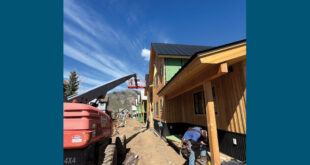“It’s not just kids vandalizing”
KBUT Community Radio is a staple of just about every workday in and around Crested Butte, but if the 240 watts pulsing from Sunlight Ridge happen to interfere with the Gunnison County Metropolitan Recreation (Met Rec) District’s analog television signal, the radio station has 48 hours to fix the problem… or turn down the volume.
The Met Rec board of directors and representatives of KBUT discussed the non-profit radio’s lease agreement at the Sunlight Ridge transmitter facility during a meeting last month.
Met Rec operates a transmission facility on Sunlight Ridge that captures an over-the-air television signal sent from Gunnison, and re-broadcasts it locally around the Crested Butte area. Over-the-air television and radio (excluding satellite and cable radio services) share space on the broadcast spectrum.
The Met Rec board had asked to revisit the open lease agreement with KBUT in order to address several recent issues at the Sunlight Ridge facility, including the radio signal interfering with the TV signal, heat in the building causing components to fail or shut down, and several break-ins that have resulted in damage to Met Rec equipment.
At the start of the meeting, KBUT general manager Dave Clayton said he and the station’s attorney had reviewed the new lease agreement.
Met Rec board president Paul Wayne Foreman wanted to discuss the issue of heat. He said the amount of equipment and energy being used in the building was creating a lot of heat, which could potentially damage equipment or cause the television signal to go off-line. Foreman said earlier on Monday the Met Rec service technician had to visit the Sunlight Ridge facility to restart the existing air conditioning unit, which had overheated and quit.
Clayton said KBUT would purchase a new air conditioning unit when the radio station goes to a digital signal.
Met Rec board member Bob Beda asked Clayton to explain the difference between standard radio and digital radio.
Clayton said with a digital radio tuner, listeners would be able to pick up additional content on the 90.3 frequency. He said most radio frequencies have some leeway in their signal range, and the efficiency of the digital transmission allowed more information to be fit into this leftover part of the broadcast spectrum. He said this space could eventually be used to provide extended news coverage or live broadcasts of special events.
Clayton said the station would still broadcast an analog signal, so no one will need a new radio in order to keep enjoying KBUT. He said the station plans on switching to digital by the end of 2009.
Met Rec business manager Lori Patin then asked about the issue of the radio signal interfering with the TV signal.
Met Rec’s service technician Cote said if KBUT was broadcasting at full power when he is simultaneously doing television signal testing at the Sunlight Ridge facility, Met Rec’s Channel 8 would have distortion, and the KBUT signal would replace the audio on the television station. When the radio station’s power was turned down, or if Cote checked the signal in the town of Mt. Crested Butte, the interference went away.
Fortunately, Cote said channel 8 wasn’t being used by any programming, so it currently wasn’t much of an issue except when he does testing. In the interest of testing and compatibility, Clayton and Cote agreed to work together to use different filters and modulators to try to reduce the interference. They agreed that if Cote needs to perform tests, he should give the current on-air DJ or Clayton a warning. That way the radio audience can be informed that the signal may be lost temporarily.
Clayton also suggested splitting the electricity bill when the radio station goes digital. Currently, KBUT just plugs in and Met Rec foots the bill. “You’ve been very generous to provide us with free power,” Clayton said. “I believe we’re probably using half the power in the building right now.”
Patin said because of TABOR, it was hard for Met Rec to accept money. She said the electricity bill could be sent directly to KBUT, and then Met Rec could compensate the station for their share of the energy use. Clayton said that was fine, and agreed to work with Patin to get the billing changed.
Finally the two groups discussed break-ins at the Sunlight Ridge facility.
In March 2009, there was a break-in at the facility and someone caused about $1,000 worth of damage to Met Rec’s equipment.
Then, in mid-July there was another break-in at the facility. This time several channel modulators were tampered with; one burnt out and had to be replaced. Following the more recent break-in, Cote said, he had installed a new hasp and Master Lock on the door.
Met Rec board member Dave McGuire asked if any of KBUT’s equipment was damaged in the last break-in.
Clayton said he only learned about the break-in last week and had not been up to the site to check the equipment. Clayton said he could tell by remote that most of the radio station’s equipment was functioning normally. Cote agreed that most of the damage appeared to be to Met Rec’s equipment.
In light of the break-ins, Foreman said Met Rec would prefer KBUT to call Cote to request access to the facility.
Clayton said KBUT sometimes needed daily access to the facility to check certain connections that cannot be monitored by remote.
Furthermore, Clayton said he was willing to install an alarm system on the door along with the digital upgrades.
Foreman said he wanted to believe that what happened in the past was the past, and wouldn’t occur again with a new lock and future alarm system.
 The Crested Butte News Serving the Gunnison Valley since 1999
The Crested Butte News Serving the Gunnison Valley since 1999

